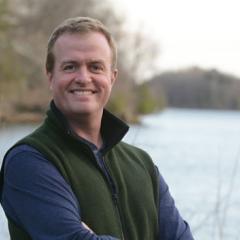Bowser profiled for work as education coordinator in Hudson River Estuary Program
Editor's note: The following piece first appeared on the Waterfront Alliance's website.
Chris Bowser is the education coordinator for the New York State Department of Environmental Conservation Hudson River Estuary Program and National Estuarine Research Reserve, in partnership with the Cornell Water Resource Institute. His professional experience includes serving as a Peace Corps Volunteer in Mauritania where he worked on dune stabilization and reforestation projects, serving as education director for the Hudson River Sloop Clearwater, mapping river shorelines, conducting environmental education workshops in Haiti, and teaching at Marist College’s environmental science department and Bard College’s environmental and urban studies program. Below, you’ll appreciate Chris’s thoughts on online learning opportunities, and don’t miss his poetic description of what’s happening underwater in the spring.
Teaching people about their local waterfronts and waterways is important even during a global health pandemic because…
…more than ever we want to remind people of shared resources, of public treasures that everyone deserves access to. These are really tough times right now. The waterways of New York are physical connections to each other, to nature, to the world. Our waterfronts, if used and visited safely, can be a source of comfort and even inspiration.
COVID-19 has changed how educators are teaching by moving learning online. I think this new way of teaching…
…is very challenging, but it also forces a new learning curve and eventual opportunities. It’s more important than ever to make sure that everyone has access to learning. Some students and teachers have support and technology and time, but for many people these resources are hard to come by. I work with an amazing team that is putting together short videos and lesson plans that strive to be useful and interesting without being a torrent of content that’s hard to sift through.
Parents and teachers are adapting to providing online learning opportunities for students. Three of my favorite websites that I would direct them to are…
There are many websites and providers out there, and it’s hard to pick favorites.
-The DEC has a great Caregiver Resources website that you can start exploring, including lesson plans specific to the Hudson River.
-To explore estuaries around the country, check out the Estuaries Education page of NOAA’s National Estuarine Research Reserve.
-And if you want to read with your kids beyond estuaries, I like the nature-focused storytelling and enthusiasm of Miss Mallory.
We can’t be together at the waterside right now, but if we could…
…see underwater, we’d see that river and harbor are bustling with life. Spring is primetime for fish migration. Recreational fisherfolk are familiar with popular species like striped bass or bluefish. But also on the move are thousands of tiny glass eels, migrating from their hatching grounds south of Bermuda and only now adapting to the freshwaters of the watershed. And while ferries and tugboats bustle across the harbor, below the waves huge sturgeon will soon be surging upriver. Unlike the eels, sturgeon spawn in freshwater, then spend many of their months cruising coastal saltwater, bulking up to ten feet long or more. And where there are fish, you might even catch a lucky glimpse of a marine mammal like a seal or whale. Be patient. The harbor will be there for us.
My greatest teachers have been…
I’ve had so many great teachers. I started my education focus aboard the Hudson River Sloop Clearwater. Founders Pete and Toshi Seeger were influential for sure, but it was really the hundreds of kids that came aboard the boat that were my best teachers. The students (and not just kids) continue to teach me what works, what doesn’t, when to listen, when to give people the space and time to learn on their own. That’s always the best.
My career highlight so far has been…
…when I see former students come back to the waterfront as volunteers, or professional educators, or river advocates, or whatever they are now that brings them back to the river. You know who you are.
I draw inspiration from…
…parents and teachers who bring their kids to the waterfront. You are doing the real and important work. If anything I do in an education program helps you with your goals, then I’m grateful to have that small role for an hour or a day.
The waterfronts in the world I’d love to explore…
…include New Zealand or Japan. I dream of seeing the various species of migratory eels across the world (yes, that is my dream), and the Japanese eels and long-finned eels are high on the list. But closer to home there are so many corners of New York Harbor that I want to explore firsthand. My seine net is always ready!
One thing about me some people find surprising is…
…I didn’t learn how to swim until I was well into my twenties. I was working on a large boat, and when the captain found out I couldn’t swim, he ordered me to spend an hour after work every day teaching myself to swim. Or at least my crude version of swimming.
Thank you, Chris!
